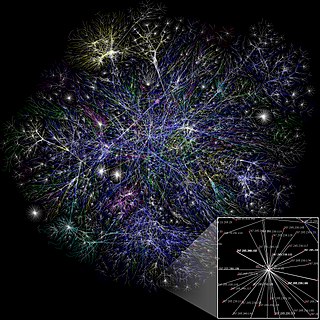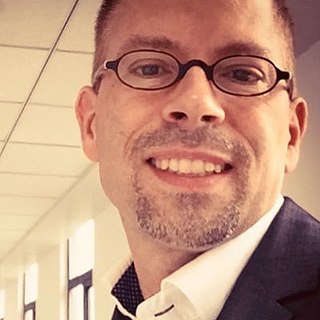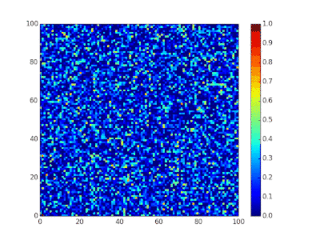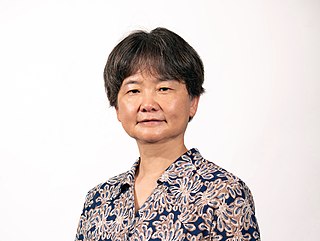Related Research Articles

The percolation threshold is a mathematical concept in percolation theory that describes the formation of long-range connectivity in random systems. Below the threshold a giant connected component does not exist; while above it, there exists a giant component of the order of system size. In engineering and coffee making, percolation represents the flow of fluids through porous media, but in the mathematics and physics worlds it generally refers to simplified lattice models of random systems or networks (graphs), and the nature of the connectivity in them. The percolation threshold is the critical value of the occupation probability p, or more generally a critical surface for a group of parameters p1, p2, ..., such that infinite connectivity (percolation) first occurs.

Mark Trodden is a theoretical cosmologist and particle physicist. He is the Fay R. and Eugene L. Langberg Professor of Physics and Co-Director of the Center for Particle Cosmology at the University of Pennsylvania.
Mark Newman is a British physicist and Anatol Rapoport Distinguished University Professor of Physics at the University of Michigan, as well as an external faculty member of the Santa Fe Institute. He is known for his fundamental contributions to the fields of complex systems and complex networks, for which he was awarded the Lagrange Prize in 2014 and the APS Kadanoff Prize in 2024.

Jens Eisert is a German physicist, ERC fellow, and professor at the Free University of Berlin. He is also affiliated with the Helmholtz Association and the Fraunhofer Society.
The clique percolation method is a popular approach for analyzing the overlapping community structure of networks. The term network community has no widely accepted unique definition and it is usually defined as a group of nodes that are more densely connected to each other than to other nodes in the network. There are numerous alternative methods for detecting communities in networks, for example, the Girvan–Newman algorithm, hierarchical clustering and modularity maximization.
In the context of the physical and mathematical theory of percolation, a percolation transition is characterized by a set of universal critical exponents, which describe the fractal properties of the percolating medium at large scales and sufficiently close to the transition. The exponents are universal in the sense that they only depend on the type of percolation model and on the space dimension. They are expected to not depend on microscopic details such as the lattice structure, or whether site or bond percolation is considered. This article deals with the critical exponents of random percolation.

Frank Verstraete is a Belgian quantum physicist who is working on the interface between quantum information theory and quantum many-body physics. He pioneered the use of tensor networks and entanglement theory in quantum many body systems. He holds the Leigh Trapnell Professorship of Quantum Physics at the Faculty of Mathematics, University of Cambridge, and is professor at the Faculty of Physics at Ghent University.

Classic epidemic models of disease transmission are described in Compartmental models in epidemiology. Here we discuss the behavior when such models are simulated on a lattice. Lattice models, which were first explored in the context of cellular automata, act as good first approximations of more complex spatial configurations, although they do not reflect the heterogeneity of space. Lattice-based epidemic models can also be implemented as fixed agent-based models.
Kathryn M. Zurek is an American physicist and professor of theoretical physics at the California Institute of Technology. Her research interests primarily lie at the intersection of particle physics with cosmology and particle astrophysics. She is known for her theories on dark matter's "hidden valleys", also known as hidden sectors.

Crispin William Gardiner is a New Zealand physicist, who has worked in the fields of quantum optics, ultracold atoms and stochastic processes. He has written about 120 journal articles and several books in the fields of quantum optics, stochastic processes and ultracold atoms.

Maria Cristina Marchetti is an Italian-born, American theoretical physicist specializing in statistical physics and condensed matter physics. In 2019, she received the Leo P. Kadanoff Prize of the American Physical Society. She held the William R. Kenan, Jr. Distinguished Professorship of Physics at Syracuse University, where she was the director of the Soft and Living Matter program, and chaired the department 2007–2010. She is currently Professor of Physics at the University of California, Santa Barbara.
Adrian Kent is a British theoretical physicist, Professor of Quantum Physics at the University of Cambridge, member of the Centre for Quantum Information and Foundations, and Distinguished Visiting Research Chair at the Perimeter Institute for Theoretical Physics. His research areas are the foundations of quantum theory, quantum information science and quantum cryptography. He is known as the inventor of relativistic quantum cryptography. In 1999 he published the first unconditionally secure protocols for bit commitment and coin tossing, which were also the first relativistic cryptographic protocols. He is a co-inventor of quantum tagging, or quantum position authentication, providing the first schemes for position-based quantum cryptography. In 2005 he published with Lucien Hardy and Jonathan Barrett the first security proof of quantum key distribution based on the no-signalling principle.
A generalized probabilistic theory (GPT) is a general framework to describe the operational features of arbitrary physical theories. A GPT must specify what kind of physical systems one can find in the lab, as well as rules to compute the outcome statistics of any experiment involving labeled preparations, transformations and measurements. The framework of GPTs has been used to define hypothetical non-quantum physical theories which nonetheless possess quantum theory's most remarkable features, such as entanglement or teleportation. Notably, a small set of physically motivated axioms is enough to single out the GPT representation of quantum theory.

Amnon Aharony is an Israeli Professor (Emeritus) of Physics in the School of Physics and Astronomy at Tel Aviv University, Israel and in the Physics Department of Ben Gurion University of the Negev, Israel. After years of research on statistical physics, his current research focuses on condensed matter theory, especially in mesoscopic physics and spintronics. He is a member of the Israel Academy of Sciences and Humanities, a Foreign Honorary Member of the American Academy of Arts and Sciences and of several other academies. He also received several prizes, including the Rothschild Prize in Physical Sciences, and the Gunnar Randers Research Prize, awarded every other year by the King of Norway.
Bogdan Andrei Bernevig is a Romanian Quantum Condensed Matter Professor of Physics at Princeton University and the recipient of the John Simon Guggenheim Fellowship in 2017.

Matthieu Wyart is a French physicist. He is a professor of physics at EPFL and the head of the Physics of Complex Systems Laboratory.
The FLEUR code is an open-source scientific software package for the simulation of material properties of crystalline solids, thin films, and surfaces. It implements Kohn-Sham density functional theory (DFT) in terms of the all-electron full-potential linearized augmented-plane-wave method. With this, it is a realization of one of the most precise DFT methodologies. The code has the common features of a modern DFT simulation package. In the past, major applications have been in the field of magnetism, spintronics, quantum materials, e.g. in ultrathin films, complex magnetism like in spin spirals or magnetic Skyrmion lattices, and in spin-orbit related physics, e.g. in graphene and topological insulators.
Tin-Lun "Jason" Ho is a Chinese-American theoretical physicist, specializing in condensed matter theory, quantum gases, and Bose-Einstein condensates. He is known for the Mermin-Ho relation.

Jingbo Wang is an Australian quantum physicist working in the area of quantum simulation, quantum algorithms, and quantum information science.

Germán Sierra is a Spanish theoretical physicist, author, and academic. He is Professor of Research at the Institute of Theoretical Physics Autonomous University of Madrid-Spanish National Research Council.
References
- 1 2 Bernardi, Dan (24 October 2023), "Physics Professor Honored by the American Physical Society", Syracuse University News, retrieved 2025-01-10
- 1 2 Curriculum vitae (PDF), Syracuse University, retrieved 2025-01-10
- ↑ "Jennifer Schwarz", Faculty, Syracuse College of Arts and Sciences, retrieved 2025-01-10